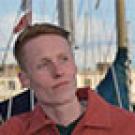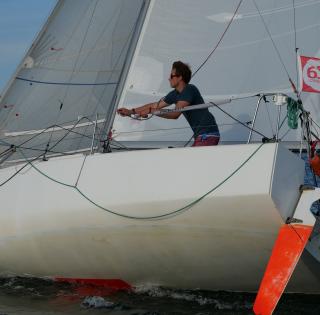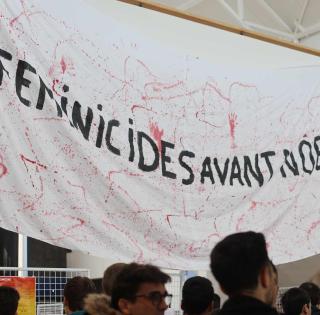
All the works and creations can be seen in the ENSTA Bretagne main hall from 11 March to 9 April. The exhibition is also available as a virtual version here.
Judicaël, a 3rd year engineering student at ENSTA Bretagne in the Hydrography/Oceanography speciality and project leader, tells us about the exhibition.

How did you come up with the idea of organizing this exhibition?
The "Call of the Oceans" project follows on from various initiatives undertaken since 2017. Indeed, during my first year at ENSTA Bretagne (in 2017), I was a member of the Enactus association working on the ENSTAqua project. At that time, I used to give talks in primary schools with the aim of making children aware of the protection of the oceans.
The current aim of the physical and virtual "Call of the Oceans" exhibition is to reach out to as many people as possible on this subject through its scientific and artistic content. We are projecting a message while promoting art in our engineering school.
Who are the members of your team? What is each member's role?
The team includes 3 female and 5 male students: Noa, Léna, Lou, Lilian, Théo, Maël, Pradosh and myself.
Other engineering students contributed to the project by creating information content.
This work was above all collective. For my part, I have been in charge of the organization and management of the exhibition since the beginning of October. There was a need to take care of the legal and administrative aspects and to liaise with the artists, the professionals and the Cèdre administration.

Marée noire en Pertuis d'Antioche
Cette série de 6 tableaux représente l'évolution d'une marée noire au large de l'île de Ré. Cette évolution a été modélisée lors d'un projet d'océanographie par des étudiants de l'ENSTA Bretagne, puis a été transformée en cartes artistiques par Marine Le Breton.
Who are your partners and what are their roles?
- Le Cèdre: Is an anti-pollution research center which has been our partner since 2017. It was already providing content in 2017 for our primary school talks with children. For the exhibition, it provided us with physical content as well as knowledge.
- Sea Plastics: we were in contact with students from AgroParisTech who were carrying out measurements of the concentration of micro-plastics in the Mediterranean Sea.
- Lords of the Oceans: is a group of 4 friends, including 2 graduates of ENSTA Bretagne, who have created a web series with the aim of giving sharks a new image.

Which artists participated in the project?
- Firstly, there were several ENSTA Bretagne students, members of the Kult’art club and of the BDAV: Maël, Jérémy, Coline, Léa, Aurélie, Taina, Tyméa, Romain and Lou.
- The leading artist is Marine Le Breton, a graphic designer and illustrator specializing in the drawing of nautical charts: she painted a series of 6 paintings about the oil spill. To produce these works, we established a partnership between ENSTA Bretagne's oceanography department and Marine Le Breton who contributed the artistic side to this scientific project.
- Bruno Panas, sculptor: ENSTA Bretagne students and apprentices attended cultural workshops led by this artist. After giving them a course on the microbiome, the aim of which was to raise awareness of marine life and more specifically of plankton, B. Panas set the engineering students the goal of creating "a valuable object derived from marine structures". The result represents the seabed and the species that are becoming dangerously accustomed to living with plastic.
- Emmanuel Le Page: author of the comic book "La lune est blanche" (The moon is white), he lent some of the plates of his book for the exhibition.
- Sylvain Coudougnan: a professional diver who installs artificial reefs and is involved in underwater photography.
- "Mâtin, quel journal!": Instagram committed page (especially as regards environmental protection) in a humorous way in the form of a digital comic magazine. They work with various artists and the publishing house Dargaud.
- Alice Leblanc Laroche, silkscreen artist: she worked with students from the University of La Rochelle to create a perpetual calendar.
A variety of media are used for the exhibition:
- Informative posters to explain the topics covered.
- Posters from researchers to present their research projects related to the topic.
- Works of art (photos, drawings, paintings and sculptures).
- Podcasts made with researchers and artists.

No one own me
Jérémy Gougeon wanted to show the effect of global warming on the polar ecosystem, while denouncing plastic pollution. Here he shows a North Pole turned into a plastic island.

What topics are addressed?
We wanted to present a variety of topics, focusing on plastics, which are one of the major issues of our time, while dealing with other subjects less known to the general public.
- Micro- and macro-plastics: At the present time, the main problem in our consumer society is that we tend to throw away waste badly and have an overly optimistic vision of recycling. The aim is to show the dangers that plastics represent for the oceans (macro- and micro-waste).
- Chemical pollution: this topic deals with oil and hydrocarbons. Pollution is not only restricted to oil spills, but also comes from other chemicals.
- Noise pollution: this is still a little-known problem, and the standards are very recent. It includes hydrography, pyrotechnics and naval and offshore architecture.
- The ecosystem: the exhibition shows the global impact of marine pollution on the ecosystem. For example, Sylvain's podcast deals with the subject very well.
What message do you want to convey through your exhibition?
The message we want to convey is firstly to raise awareness of the dangers that now threaten the oceans, while showing that initiatives to protect them are being taken and in which each of us can play their part.













